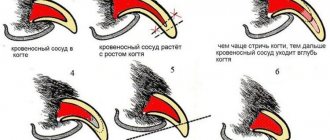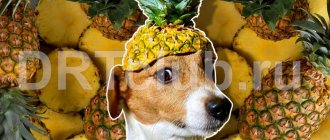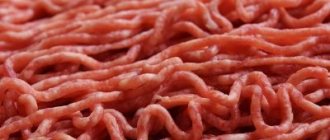At two months, the kitten is weaned from its mother, and less often, it is weaned from breastfeeding. But in any case, it is transferred to the “adult” menu.
This is no longer feeding, like for one-month-old babies, but a complete diet. The more balanced and nutritious it is, the healthier the puppy will grow up.
During this period, it is important to properly plan your diet. If the dog is the first, it is easy to make mistakes that will affect the body. We will consider in detail the issue of feeding two-month-old puppies, as well as the nutritional features of large, medium-sized and decorative breeds.
Basic feeding rules
Two months is the most difficult age for puppies. They experience stress after stress: moving to a new home, first vet visits and vaccinations, meeting new people, places and animals. In addition, two-month-old kittens grow rapidly: from 8 to 12 weeks their weight doubles.
Let's look at the basic rules that should be taken into account when feeding puppies.
For the first 2 weeks after purchasing the baby, he is fed the same food as the breeder
. Only in the 3rd week do they change the diet, introducing new products and gradually increasing their volume. If you immediately transfer the puppy to a new menu, disruption of the gastrointestinal tract is guaranteed.
The approximate diet for two-month-old kittens consists of: 40-45% meat, 35-40% dairy and fermented milk products, 15-30% vegetables, cereals and other foods
. But these proportions are approximate and depend on the breed (naturally, the needs of a Yorkie and a Shepherd are different), size, gender and individual development of the dog.
Meat is the main component.
It is given at the rate of 15-30 g per 1 kg of weight per day. However, the calculations are again approximate and depend on individual factors.
For example, bulldogs feel great on a low-protein diet, while huskies have only 25 g of meat. Here they focus on the characteristics of the breed and the well-being of the baby.
Food temperature – room temperature or slightly higher
. Hot and cold foods irritate the esophagus and stomach.
An important question is how many times a day should you feed a two-month-old puppy?
Food should be given 5-6 times a day at regular intervals.
By the 3-4th month, reduce the number of meals to four. Avoid night feedings after 10-11 pm - the baby’s stomach should rest.
Feeding should be done every day at a certain time
to develop a diet.
Provide constant access to water.
It is recommended to change the water 2-4 times a day, because... When drinking, food debris, saliva, fur, and dirt get into the liquid.
It is advisable to use bowls with a stand.
Their height is adjustable so that the pet keeps its neck straight without stretching it up or down. Otherwise, a high load is created on the shoulder girdle, which over time can lead to deformation of the skeleton.
Remember that it is at 2 months that the puppy develops eating habits and the concept of a routine. Instill a love for quality nutrition by the hour and you will get a healthy, hardy dog.
Do I need to soak dry food?
At two months, the puppy already has a full set of baby teeth and, in principle, copes well with solid food, so it is not at all necessary to soak dry food. However, sometimes puppies prefer wet food, so you can add a little warm water to the dry food before feeding - this will be enough to make the food smell more intense to your pet.
When feeding dry food, water is a subject of special concern for the owner. It should always be freely available and in sufficient quantities. The larger the volume of liquid, the longer it remains fresh, so a saucer is not suitable for a puppy - it is better to immediately take a sufficiently capacious bowl. Change its contents often using filtered drinking water.
What is better for a puppy: natural food or ready-made food?
There are 2 types of dog food - natural and ready-made food (dried, canned). Which diet is better - there is no clear answer.
Some owners or breeders believe that it is impossible to balance a puppy’s diet on a natural menu: in order to calculate the calories, vitamins, minerals consumed by the dog and their expenditure, a laboratory is needed. Others believe that industrial feeds are divorced from natural nutrition and you cannot be sure of the quality of the products.
It is worth considering that:
- “Naturalka” takes time to purchase products, prepare and create a menu. This option is unlikely to be suitable for busy owners.
- It is not recommended to mix natural and prepared diets even at different meals.
- Ready-made meals will save time, but will cost significantly more. After all, you will have to buy high-quality food for your puppy. Feeding “economy class” food to children is not acceptable.
If dry food, what kind?
If you prefer ready-made food, buy holistic or super-premium grain-free brands. They are the best.
Advice - forget about advertised companies like Pedigree, Chappi. Focus on the composition and reviews of breeders and veterinarians.
The best food for small breeds
(Yorkshire Terrier, Pomeranian Spitz, Chihuahua, Miniature Poodle, etc.):
- Applaws with chicken for small and medium breeds;
- Acana Heritage for small puppies;
- Guabi Natural for miniature puppies;
- 1st Choice for decorative and small breeds.
Recommended food lines for large and medium breed
(spaniel, labrador, alabai, etc.):
- Orijen for large puppies;
- Applaws for large breed puppies;
- Acana Heritage for large puppies;
- Savarra for large breed meat with lamb and rice.
Suitable for everyone, from a toy terrier to a Tibetan mastiff:
- Orijen grain-free for puppies;
- Grandorf hypoallergenic with lamb and rice for puppies of all breeds - it is recommended for breeds with a tendency to food allergies: pugs, French bulldogs, Shar Peis, Pekingese;
- Optima Nova Sensitive with salmon and potatoes for all puppies;
- Genesis Pure Canada Green Highland Puppy;
- Carnilove salmon and turkey puppies;
- Pronature Holistic for chicken and potatoes;
- Barking Heads Puppy Days with salmon and trout.
Opinions are also divided on whether it is worth soaking the food. The two-month-old puppy no longer has problems chewing and digesting food. The only thing is that he can refuse “crackers”, because... they look and smell unusual. In this case, add a little warm water to the dryer before feeding.
Rating of the best treats for dogs
To make it easier for an inexperienced owner to choose the first treat for their dog, we suggest studying the rating of the best treats, compiled based on reviews from experienced breeders and pet owners.
Top 5:
1. PEDIGREE Markies - meat cookies.
Low cost, does not cause adverse reactions, can be taken for walks and used for training. 2. “Village Treats” – rabbit ears. Natural composition, do not cause allergic reactions, improve dental health. 3. Titbit Fitness muesli - contains only natural ingredients, has a therapeutic and prophylactic effect, affordable price, large selection of flavors. 4. Happy Dog – chewy sausages. High-quality composition, good for dental health, affordable price of the product. 5. Bosch Biscuit lamb and rice - well absorbed by the body, healthy composition, hypoallergenic, high quality product. You should not buy the same treat for your dog. Animals, like people, love variety in their diet.
If you don’t have store-bought treats on hand, you can pamper your beloved dog with delicious homemade treats made from high-quality and healthy ingredients.
Encourage your pet for obedience and good behavior, using not only treats as a reward, but also regular praise and care, and then your dog will become the most loyal and best friend!
How to determine the correct serving size?
New owners of two-month-old puppies often go from one extreme to another: either it seems to them that they are overfeeding the baby, or they think that they are underfeeding.
Both overeating and undereating are bad. But for the health of the heart and joints, it is better to slightly (just slightly!) underfeed your dog. This advice is especially useful for large breeds (such as German and Caucasian Shepherds, Alabai, VEO), whose bones and ligaments are already under heavy stress.
The amount of daily food should be approximately 5-7% of the dog’s weight or 260-270 kcal per 1 kg. But this is an average rule.
You can more accurately determine what portions to give your puppy at 2 months.
Place a bowl of food. Normally, the baby eats food in 10-15 minutes and licks the bowl a couple of times. If after 15-20 minutes there are food left, you are overfeeding the dog. If your pet swallows a portion in 2-5 minutes and licks the dishes for a long time, you are underfeeding.
There is another option. Give the puppy a known large portion. Keep an eye on the dog: as soon as the last (false) ribs are visible, take the bowl away. This way you will slightly underfeed the dog. This method is used for hunting breeds of lean build - shorthaired pointer, drathaar, Russian hunting spaniel.
There is no such problem with ready-made food. The package indicates the exact daily drying volume based on the weight of a two-month puppy. The only thing is that the amount sometimes has to be adjusted if the baby has an accelerated or slow metabolism.
Supplements to the basic diet
It’s hard to imagine a complete diet for a two-month-old puppy without fortified supplements and “snacks.” The main thing is to know which and how much you can give.
Vitamins and minerals
Mineral and vitamin supplements are not needed when feeding prepared foods. The dryer already contains all the necessary components. If additional drugs are administered, this will lead to hypervitaminosis.
But natural nutrition is difficult to balance. Therefore, vitamins and minerals are required.
There are 2 types of vitamin and mineral supplements:
- Industrial.
The best are considered to be 8 in 1 Excel Multi Vit, Canvit Junior, Beaphar for puppy, Biorhythm, Doctor Zoo.- Natural.
Brewer's yeast, feed sulfur, bone meal, calcined cottage cheese, fish oil.
Puppies of large breeds (for example, VEO, St. Bernard, Rottweiler, Alabai, Samoyed) are given calcium, phosphorus and magnesium for the proper formation of bones and joints.
And in winter, fish oil and vitamins A and D are recommended for 2-month-old kittens to prevent rickets.
Goodies and treats
Any dog is sure that a day without a treat will be in vain. To please your pet and not harm her, select healthy treats:
- Ready from stores.
Dried offal, dried meat without salt and seasoning, deer antlers, cookies, sinew bones. - Made at home.
Bread crumbs, oven-dried meat, hard unsalted cheese.
Giving a 2-month-old puppy unlimited amounts of treats is prohibited. This is just a way to please your baby, encourage good behavior, develop a necessary habit, or teach a command.
The maximum daily amount of treats is no more than 10% of the total diet.
Basic prohibitions
There are foods that are undesirable or strictly prohibited to be given to two-month-old puppies. Of course, the first thing that is dangerous is constant feeding of junk food. But even an accidentally eaten piece can cause serious consequences.
It would seem that a tiny piece of chocolate or sausage once a month will not affect the puppy’s health. But it's not that simple. The product may not harm, for example, a large husky. But for small Shih Tzus or Chihuahuas, a dose of dangerous ingredients in a piece will be fatal.
Strictly prohibited and “controversial” products
Absolutely harmful to all puppies:
- salty, spicy, smoked, fried, fatty foods;
- semi-finished products and fast foods;
- sausages, canned food, marinades;
- garlic, onion;
- citrus fruit;
- sweets (especially chocolate), confectionery and bakery products;
- grapes, raisins;
- tubular bones of poultry, fish, leather;
- mushrooms, nuts;
- alcoholic, carbonated, sweet drinks.
Some of these products lead to health problems if consumed regularly. Others immediately cause intoxication, allergies, and gastrointestinal disorders.
There are products that some owners consider undesirable, while others consider them harmless if consumed rarely. This:
- pork - raw meat is fatty, may contain helminths, but boiled meat can be fed occasionally;
- potatoes are pure starch when boiled, but you can treat them with 1-2 slices of raw root vegetables;
- tomatoes - a large amount can lead to poisoning, but in small doses they remove plaque from teeth;
- honey is an allergen, but at the same time a storehouse of useful substances;
- semolina and pearl barley are pure carbohydrates and cause bloating, but porridge with milk helps exhausted babies at 2 months to gain weight;
- peas, soybeans, beans, beans, corn: they cause gas formation and are difficult to digest, but if the dog loves them, a few grains will not harm.
Unwanted Products
Undesirable foods are divided into those that should not be given categorically, and those that should be given with caution and monitor the reaction.
We give with caution:
- poultry meat,
- Rice (may cause constipation)
- Pearl barley (poorly digested),
- Peas and potatoes (increases gas formation).
Prohibited products:
- Pork and lamb,
- Bones, especially chicken bones,
- Sweets,
- Garlic and onion
- Citrus and sour fruits,
- Bread, pasta,
- Salt, spices, seasonings, spicy foods.
- Smoked meats.
“Human” food is generally not desirable even for an adult dog, much less for a puppy.
Features of the diet of two-month-old puppies of different breeds
The nutrition of two-month-old puppies of different breeds is different. And this is natural. For example, Chihuahuas and Huskies have different metabolisms, sizes, physical activity levels, and genetic makeup. In particular, how, what and how much to feed the kitten largely depends on the size of the breed.
Large and gigantic
Large and giant dogs are the most difficult to raise. These are breeds such as Alabai, Doberman, Rottweiler, St. Bernard, Great Dane, Newfoundland, East European Shepherd (VEO), etc.
Large dogs gain weight rapidly. But the skeleton does not have time to get stronger, so it often becomes deformed. Plus the heart can't cope with pumping blood. Therefore, large pets often suffer from diseases of the musculoskeletal system and the cardiovascular system.
The imbalance will level out by the age of one year, but until then, body weight and nutrition are carefully monitored.
The diet of a 2-month-old large breed puppy should consist of:
– 60% from animal proteins (meat, fish, offal, milk),
– 20-30% – from carbohydrates (cereals, fruits),
– 10-15% – from fiber (vegetables) and other foods.
Chondoprotectors are required - they are needed for the formation of joints, cartilage, and ligaments.
An example menu for a large or giant breed puppy at 2 months:
- first breakfast – cottage cheese with milk;
- second breakfast - chopped meat with boiled vegetables and a teaspoon of olive oil;
- lunch – buckwheat porridge with meat broth;
- second lunch - rice or rolled oats cooked in milk;
- afternoon snack – grated or chopped apples, pears, carrots;
- dinner - chopped offal or chopped fish with vegetables and vegetable oil.
The importance of proper puppy nutrition
You can feed a two-month-old puppy natural food or ready-made food. To independently control the quality of products, choose the first option. If you don’t have enough free time, use the second one.
It is important not to give your kitten unhealthy foods (chocolate, flour, processed foods, spices) and to follow the “basic rules.”
However, a couple of prohibitions can be broken. For example, bones are harmful. But for the development of jaws and relieving itching in the gums, large bones with rounded edges - moslaks - are given. The dog will not be able to chew them and swallow the sharp pieces. You can still add a pinch of salt to your serving once a day - it helps maintain the water-salt balance.
Please remember that all recommendations are general in nature. No one knows a dog better than the owner. Therefore, nutrition is adjusted individually, including taking into account the pet’s preferences.
You may also be interested in:
- Healthy porridge for dogs - how to cook tasty and satisfying.
- What vegetables can be given to dogs, and which are prohibited?
Meet the family
The puppy gets used to the new family and place of residence through communication and spending time together. It is very important to treat your new pet with care and kindness. Do not make your puppy feel timid, afraid and helpless, and then he will trust you. It is under such conditions that the so-called good contact arises.
During this period, it is very important to form close contact between the owner and the animal. This will speed up the process of training, educating and training the dog. Therefore, it is the owner who must devote the greatest amount of time to the dog and teach basic skills. The rest of the family can participate in raising the puppy, but only when necessary.
Whether contact has been established can only be determined by the dog’s behavior. If she whines, waits at the door during your absence, runs after you, caresses you, strives to play with you and attracts your attention in every possible way, then you have succeeded.











